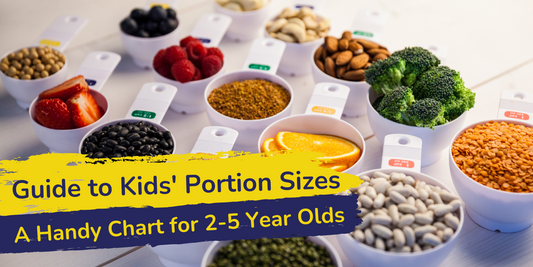
How to Reduce Sugar Intake for Kids: A Parent’s Guide to Healthy Limits
Picture this: your child’s morning starts with a fruity yogurt, continues with a cereal bar during school break, and ends with a ketchup-dipped dinner. Seems harmless? Unfortunately, sugar has snuck in at every step.
Sugar is one of the most common ingredients found in modern-day processed foods, and unfortunately, it’s one that can have significant negative effects on children’s health. In today’s world, children are consuming more sugar than ever before, and it’s not just the obvious sweet treats like candies and desserts—it’s hidden in many packaged foods, drinks, and even savory items.
The World Health Organization (WHO) has raised concerns about the growing consumption of added sugars and its harmful effects, including obesity, diabetes, and tooth decay. (WHO, 2015)
Research shows that children’s sugar intake has steadily increased over the years, and according to the American Heart Association (AHA), most kids exceed the recommended sugar limits by consuming sugary drinks, snacks, and processed foods. This trend poses serious long-term health risks, making it essential for parents to understand how much sugar is too much and how to reduce it effectively (AHA, 2018).
How Much Sugar Is Too Much?

When it comes to sugar intake, knowing how much is appropriate for your child is crucial. Both the World Health Organization (WHO) and the American Heart Association (AHA) provide guidelines on the daily sugar intake for children, which are designed to help parents limit sugar in their diets and protect their health.
WHO and AHA Recommendations for Daily Sugar Intake for Kids:
• WHO recommends that added sugars should make up no more than 10% of a child’s total daily calories. For children aged 2-18, this is roughly 25 grams (6 teaspoons) of sugar per day.
• AHA recommends a stricter limit: for children aged 2-18, no more than 25 grams (6 teaspoons) of added sugar daily (AHA, 2018).
The major difference between added sugars and natural sugars lies in how they are processed by the body. Added sugars are those incorporated into foods during processing or preparation, such as in sweetened cereals or fruit juices. Natural sugars, on the other hand, are found naturally in whole foods, like fruits and dairy products, and come with additional nutrients like fiber, vitamins, and minerals.
Natural vs. Added Sugars
| Natural Sugars | Added Sugars |
|---|---|
| Found in whole foods (e.g., fruits, vegetables, milk) | Added to foods and beverages during processing (e.g., candy, sodas, snacks) |
| Come with vitamins, minerals, and fiber | Provide empty calories with little to no nutritional value |
| Digested more slowly due to fiber content | Rapidly absorbed by the body, causing blood sugar spikes |
| Do not contribute to obesity or chronic issues when moderate | Linked to obesity, type 2 diabetes, and heart disease when consumed in excess |
| Source: WHO, 2015 |
20 Effects of Sugar on Kids’ Health
1. Increased Risk of Heart Disease

High sugar intake may seem like a concern only for adults, but studies show that children who consume lots of added sugar can develop early risk factors for heart disease. Too much sugar increases levels of harmful fats in the blood (like triglycerides), raises bad cholesterol, and can contribute to high blood pressure—all laying the groundwork for heart trouble later in life.
2. Weakened Concentration and Focus
Sugar causes blood sugar to spike rapidly and then crash. These sharp drops can leave a child feeling sluggish, distracted, or irritable. In a classroom setting, this can make it harder for them to sit still, listen carefully, and retain information—directly affecting their ability to learn and perform.
3. Higher Likelihood of Metabolic Disorders

When children consistently consume more sugar than their bodies need, their insulin response may become less effective over time. This condition, known as insulin resistance, is a key contributor to metabolic disorders such as prediabetes and Type 2 diabetes, conditions that are increasingly seen in children today.
4. Hormonal Imbalance
Sugar doesn’t just impact energy—it disrupts hormones too. It confuses the delicate signals that tell your child when they’re hungry or full, leading them to crave more food (especially sweets) even when they’ve eaten enough. This can contribute to irregular eating patterns and emotional eating habits.
5. Increased Risk of Childhood Obesity

Foods high in sugar are often dense in calories but low in nutrients. When these foods are consumed often, they can cause weight gain without truly satisfying hunger. Obesity in childhood is not only difficult to reverse—it increases the risk of asthma, joint pain, social isolation, and chronic diseases in adulthood.
6. Poor Sleep Quality
Children need deep, uninterrupted sleep for healthy development. However, high sugar consumption can overstimulate the nervous system and make it harder to fall asleep. It can also lead to restlessness during the night, meaning less time in the deep sleep that helps kids grow and heal.
7. Weak Bone Health
Sugar competes with important minerals in the body—especially calcium. Over time, diets high in added sugars can reduce calcium absorption and impair the growth of strong, healthy bones. For children in their peak growth years, this can mean weaker bone density and a higher risk of fractures.
8. Reduced Immune Function
Just a single sugary drink can temporarily weaken a child’s immune system by lowering the activity of white blood cells—the body’s defense against germs. Regular sugar intake may leave kids more vulnerable to infections like colds, flu, and sore throats, especially during school season.
9. Increased Risk of Fatty Liver Disease
Fructose, a type of sugar found in many processed foods and sodas, is metabolized by the liver. When consumed in excess, the liver converts it into fat, which can accumulate over time—leading to non-alcoholic fatty liver disease(NAFLD). This condition is becoming more common in children and often goes unnoticed until it’s serious.
10. Mood Swings and Irritability

After a sugary snack, children might feel a short-lived “sugar high” followed by a dramatic drop in energy. These sugar crashes can lead to irritability, moodiness, or even aggression. If this cycle repeats throughout the day, it can feel like an emotional rollercoaster—for both the child and the parent.
11. Poor Gut Health
Sugar feeds harmful bacteria in the digestive system. When bad bacteria flourish, it disrupts the balance of the gut microbiome—leading to digestive discomfort like gas, bloating, or constipation. Since the gut also plays a role in mood and immunity, this imbalance can have far-reaching effects.
12. Skin Problems
Children prone to skin issues like acne, rashes, or eczema may see their symptoms worsen with high sugar consumption. Sugar promotes inflammation in the body, which can show up as irritated skin, more breakouts, or flare-ups of chronic skin conditions.
13. Behavioral Issues
While sugar doesn’t cause ADHD, some children become more hyperactive or emotionally dysregulated after consuming sweets. The combination of energy spikes and poor impulse control can make tantrums more frequent or intense, especially in toddlers and preschoolers.
14. Sugar Cravings and Dependence
Sugar stimulates dopamine—the brain’s “feel-good” chemical—just like addictive substances. The more sugar a child consumes, the more their brain craves it. This can lead to a cycle where they seek out sweet foods frequently, sometimes even feeling upset or irritable when they don’t get it.
15. Reduced Nutrient Intake
Sugary foods are often chosen instead of fruits, vegetables, protein, and whole grains. When this happens consistently, children miss out on essential nutrients like iron, calcium, fiber, and healthy fats—nutrients they need to grow, think clearly, and stay active.
16. Increased Infections
Frequent sugar consumption weakens the immune response, and children who consume a lot of sugar tend to fall sick more often. Their bodies become less efficient at fighting off viruses and bacteria, resulting in more absences from school and slower recovery from common illnesses.
17. Systemic Inflammation
Chronic inflammation is an invisible but harmful process in the body. It’s linked to a range of health concerns, from autoimmune issues to early heart disease. A high-sugar diet fuels this inflammation, keeping the body in a constant low-level state of stress.
18. Disrupted Appetite Regulation
When children regularly consume high-sugar foods, their ability to sense true hunger or fullness gets skewed. They may start eating based on habit, boredom, or craving—rather than real need—making it harder to maintain a healthy relationship with food as they grow.
19. Greater Risk of Allergies and Sensitivities
An unbalanced gut microbiome (which can be affected by sugar) may increase the risk of food intolerances, sensitivities, and even environmental allergies. This can result in skin reactions, digestive upset, or heightened sensitivity to certain ingredients.
20. Poor Muscle Development
For children to build strong muscles and stay active, they need enough protein and key nutrients like magnesium and potassium. Sugar-rich diets often lack these building blocks, which can slow muscle development and lower energy levels during physical play or sports.
Where Sugar Hides in Your Child’s Diet

Even when you think you're feeding your child a balanced diet, added sugars may still be sneaking onto their plate. Many products marketed as “healthy,” “natural,” or “kid-friendly” often contain surprising amounts of added sugar. These hidden sugars can add up quickly and make it hard to stay within healthy daily limits. Here's a closer look at where sugar loves to hide in everyday meals and snacks:
Breakfast Traps
1. Sweetened granola or cereal bars – Often high in sugar from syrups or chocolate chips, making them less healthy than they appear.
2. Bottled or canned fruit smoothies – Typically contain added sweeteners or fruit purées that can spike blood sugar.
3. Croissants and store-bought pastries – These baked goods often hide sugar in the dough or glazes.
4. Toast with fruit jams and jelly – Even on whole wheat bread, jams can add a hefty dose of refined sugar; opt for “no added sugar” versions or mashed fruit.
Snack-Time Culprits
1. Crackers with hidden sugar (like graham crackers) – May not taste sweet, but sugar is added for flavor and preservation.
2. Dried fruit with added sugar (e.g., sweetened cranberries) – Often sweetened during processing; choose unsweetened versions instead.
3. Fruit cups in syrup – Usually packed in sugary syrup; go for fruit in water or 100% juice for a healthier option.
Condiments and Sauces
1. Store-bought mayonnaise – Often includes added sugar to balance tanginess; always check the label.
2. Bottled stir-fry sauces – Sauces like teriyaki or hoisin usually have high sugar content to boost flavor.
3. Pre-made marinades – Sugar is commonly added for caramelization; homemade versions are a healthier choice.
4. Canned baked beans – Can pack several teaspoons of sugar per serving; opt for reduced-sugar or DIY options.
Beverages
1. Flavored coconut water – Often sweetened with added sugars or fruit concentrates despite its healthy image.
2. Bottled "fruit-infused" water – Usually contains added sugars and flavors; try infusing plain water with real fruit slices instead.
Conclusion
Reducing sugar doesn’t mean cutting out fun or flavor—it’s about balance, awareness, and gentle swaps. By staying curious about labels and focusing on whole foods, you can support your child’s well-being from the inside out.
Let’s raise confident, nourished little explorers—one sugar-savvy bite at a time.






